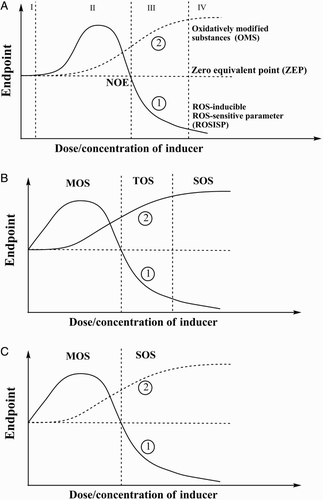Figures & data
Figure 1 Time-course of ROS level at induction of oxidative stress. (A) Under normal conditions ROS steady-state level fluctuates in a certain range, but when disturbed by an oxidant it may be increased. Further, it can either quickly return into the initial corridor (acute oxidative stress), or slowly return with stabilization at a slightly higher level than under normal conditions, with inclusion of all or part of the initial steady-state level, and finally it may stabilize at a higher quasi-stationary level. (B) Perturbations of steady-state ROS level may result in its increase followed by a return either to the initial or an even lower level (modified from Ristow and SchmeisserCitation13).

Figure 2 Schematic presentation of classification of oxidative stress based on its intensity. All diapason of relationship ‘Endpoint’ and ‘Dose/concentration of inducer’ is divided for: (A) four zones, namely I – basal oxidative stress (BOS), II – low intensity oxidative stress (LOS), III – intermediate intensity oxidative stress (IOS), and IV – high intensity oxidative stress (HOS); (B) for three zones, namely mild oxidative stress (MOS), temperate oxidative stress (TOS), and severe (or strong) oxidative stress (SOS); and (С) for two zones, namely mild oxidative stress (MOS) and strong oxidative stress (SOS). NOE = no observable effect point.

